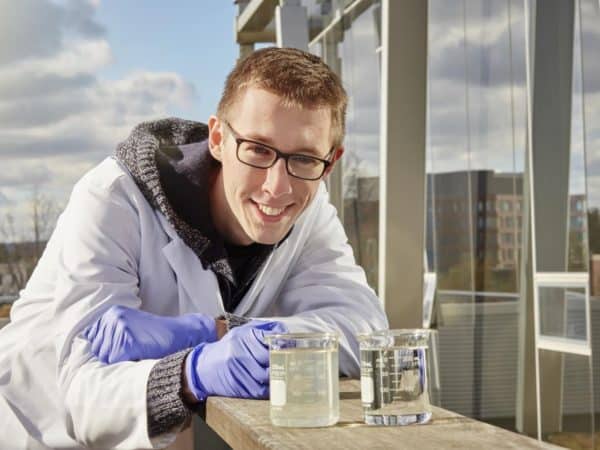

The process, which employs a chemical reaction called photocatalysis, can remove naphthenic acids from tailings ponds that would otherwise contain the harmful byproducts of crude oil refining by exposing them to sunlight and nanoparticles. The researchers published a study in the journal Chemosphere called “Solar photocatalytic degradation of naphthenic acids in oil sands process-affected water” that claims their process is better and cheaper than traditional methods of dealing with waste; the use of chlorine or membrane filtering, a technique that uses a porous physical barrier to separate particles in a fluid.
The study’s lead author, Tim Leschuk, says the sheer volume of polluted wastewater makes this a significant discovery.
“With about a billion tonnes of water stored in ponds in Alberta, removing naphthenic acids is one of the largest environmental challenges in Canada,” says Leshuk, who is a PhD candidate in chemical engineering at Waterloo. “Conventional treatments people have tried either haven’t worked or if they have worked they’ve been far too impractical or expensive to solve the size of the problem. Waterloo’s technology is the first step of what looks like a very practical and green treatment method.”
Alberta’s tailings ponds, according to Alberta Environment, cover 176 square kilometres and contain enough liquid to fill 390,000 Olympic-sized swimming pools. According to Calgary enviro-watchdog the Pembina Institute, by 2022 a month’s worth of wastewater could cover New York City’s Central Park with a sludge that would measure 11 feet deep.
Although there have been various moves to try and clean up Alberta’s tailings ponds, the pools of toxic sludge remain one the notable black eyes on the province’s oil sands industry. In October, two companies, Coal Valley Resources Inc. and Sherritt International Corporation were charged for a 2013 spill that saw approximately 670-million litres of waste water burst free near Hinton. Environment Canada’s National Pollutant Release Inventory said the ponds contained arsenic, mercury and cadmium.
But change may already be afoot for Alberta. On Sunday, the province’s New Democrat Premier, Rachel Notley, said Alberta will introduce a carbon tax in 2017. Notley said the tax, which would limit emissions from the oil sands, would generate $3-billion, annually.
Notley, who came to power in May after a stunning shift that saw the Conservative Party relinquish 44-consecutive years in power, says she sees no future for Alberta’s oil sands, despite the fact that it currently produces two-million barrels of crude each day.
“I don’t think we are defined by energy,” Notley told the U.K’s Guardian recently. “Certainly in the short to medium term that is an asset that we have, so we have to look at how we develop it carefully and responsibly because of the obligation we have to the people employed in the industry.”
Below: The Edmonton Journal says Oilsands Tailings Ponds are a Growing Problem
Leave a Reply
You must be logged in to post a comment.




 Share
Share Tweet
Tweet Share
Share




Comment